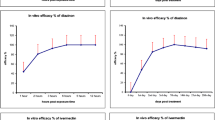Abstract
Ticks have massive capacity of acting as vectors of numerous pathogens that affect human, livestock and pets, which owes to their medical and veterinary importance. In animals, tick infestations are much more severe than in humans. Animals can be parasitized by hundreds or even thousands of ticks, which then proliferates the effect on the host. In almost all tropical and subtropical countries like India not only the hard ticks (Ixodidae) but also the soft ticks (Agrasidae) are responsible for economic losses either by direct injuries or disease transmission. Presently used control measure for ticks is only the use of commercially available acaricide compounds which are not much satisfactory and therefore a check on efficacy of these compounds is necessary for effective control. Commercially available preparations of deltamethrin (Butox, 1.25% E.C.) and cypermethrin (Ectomin, 10% E.C.) were compared for the acaricidal activity against soft ticks, Ornithodoros moubata by using Larval Packet Test. Larval mortality was higher with Butox as compared to Ectomin. Butox elicits 70% larval mortality, at the manufacturer’s recommended dosage (25 ppm) while for Ectomin, larval mortality was 38.46% at the manufacturer’s recommended dosage (200 ppm). This illustrates that deltamethrin (Butox) is more effective then cypermethrin (Ectomin).


Similar content being viewed by others
References
Bouwknegt C, Van Rijn PA, Schipper JJ, Hölzel D, Boonstra J, Nijhof AM, Van Rooij EM, Jongejan F (2010) Potential role of ticks as vectors of bluetongue virus. Exp Appl Acarol 52:183–192
FAO (1971) Recommended methods for the detection and measurement of resistance of agricultural pests to pesticides—tentative method for larvae of cattle ticks, Boophilus microplus spp. FAO method No. 7. FAO Plant Protect Bull 19:15–18
Finney DJ (1952) Probit analysis—a statistical treatment of the sigmoid response curve. Cambridge University press, Cambridge, pp 1–318
Ghavami MB, Goli S, Mohammadi J, Vatandoost H (2015) Susceptibility level of Ornithodoros tholozani (Acari: Argasidae) to some pesticides in North West of Iran. Persian J Acarol 4:83–94
Jongejan F, Uilenberg G (2004) The global importance of ticks. Parasitology 129:S3–S14
Kumar S, Sharma AK, Ray DD, Ghosh S (2014) Determination of indiscriminating dose and evaluation of amitraz resistance status in different field isolates of Riphicephalus (Boophilus) microplus in India. Exp Appl Acarol. doi:10.1007/s10493-014-9789-8
Matias PJS, Marcio BC, Hernani GCR, Marcos VG, Karina CC, Adriano P, Viviani AV, Georgia MM, Jose Mauricio BD, Marcelo B (2007) Labruna species diversity and seasonality of free living ticks (Acari: Ixodidae) in the natural habitat of wild marsh deer (Blastocerus dichotomus) in southeastern Brazil. Vet Parasitol 143:147–154
Rajput ZI, Hu SH, Chen WJ, Arijo AG, Xiao CW (2006) Importance of ticks and their chemical and immunological control in livestock. J Zhejiang Univ Sci B 7:912–921
Ruedisueli FL, Manship B (2006) Tick identification key. University of Lincoln. http://webpages.lincoln.ac.uk/fruedisueli/FR-webpages/Parasitology/Ticks/tik/tickkey/softticks-adult.Htm
Sharma AK, Kumar R, Kumar S, Nagar G, Singh NK, Rawat SS, Dhakad ML, Rawat AKS, Ray DD, Ghosh S (2012) Deltamethrin and cypermethrin resistance status of Rhipicephalus (Boophilus) microplus collected from six agro-climatic regions of India. Vet Parasitol 188:337–345
Shyma KP, Kumar S, Sharma AK, Ray DD, Ghosh S (2012) Acaricide resistance status in Indian isolates of Hyalomma anatolicum. Exp Appl Acarol 58:471–481
Shyma KP, Kumar S, Sangwan AK, Ray DD, Ghosh S (2013) Acaricide resistance status of Rhipicephalus (Boophilus) microplus and Hyalomma anatolicum collected from Haryana. Indian J Anim Sci 83:591–594
Shyma KP, Gupta JP, Ghosh S, Patel KK, Singh Veer (2014) Acaricidal effect of herbal extracts against cattle tick Rhipicephalus (Boophilus) microplus using in vitro studies. Parasitol Res. doi:10.1007/s00436-014-3839-3
Shyma KP, Gupta JP, Singh Veer, Patel KK (2015) In vitro detection of acaricidal resistance status of Rhipicephalus (Boophilus) microplus against commercial preparation of deltamethrin, flumethrin, and fipronil from North Gujarat, India. J Parsitol Res. doi:10.1155/2015/506586
Singh NK, Jyoti HaqueM, Singh H, Rath SS, Ghosh S (2014) A comparative study on cypermethrin resistance in Rhipicephalus (Boophilus) microplus and Hyalomma anatolicum from Punjab (India). Ticks Tick-borne Dis 5:90–94
Singh NK, Gelot IS, Jyoti, Singh V, Rath SS (2015) Detection of amitraz resistance in Rhipicephalus (Boophilus) microplus from North Gujarat India. J Parasit Dis 39:49–52
Telmadarraiy Z, Bahrami A, Vatandoost H (2004) A survey on fauna of ticks in west Arabian province Iran. Iran J Publ Health 3:65–69
Telmadarraiy Z, Nasirian N, Vatandoost H, Abolhassani M, Tavakoli M, Zarei Z, Banafshi O, Rafinegad J, Salarilak SH, Faghihi F (2007) Comparative susceptibility of cypermethrin in Ornithodoros lahorensis and Argas persicus field populations. Pak J Biol Sci 10(23):4315–4318
Tolleson DR, Teel PD, Stuth JW, Strey OF, Welsh TH, Carslens GE (2007) Fecal NIRS: detection of tick infestations in cattle and horses. Vet Parasitol 144:146–152
Walker AR, Bouattour A, Camicas JL, Estrada-Pena A, Horak IG, Latif AA, Pengram RG, Preston PM (2003) Domestic animals in ticks of domestic animals in Africa: a guide to identification of species. The University of Edinburgh, UK
Acknowledgements
The authors are thankful to the Director of Research and Dean, College of Veterinary Science and Animal Husbandry, Sardarkrushinagar Dantiwada Agricultural Universitry, for providing facilities to carry out the research work.
Author information
Authors and Affiliations
Corresponding author
Rights and permissions
About this article
Cite this article
Sharma, N., Singh, V., Shyma, K.P. et al. Comparative efficacy of commercial preparation of deltamethrin and cypermethrin against Ornithodoros spp. of North Gujarat. J Parasit Dis 41, 1139–1142 (2017). https://doi.org/10.1007/s12639-017-0947-x
Received:
Accepted:
Published:
Issue Date:
DOI: https://doi.org/10.1007/s12639-017-0947-x




